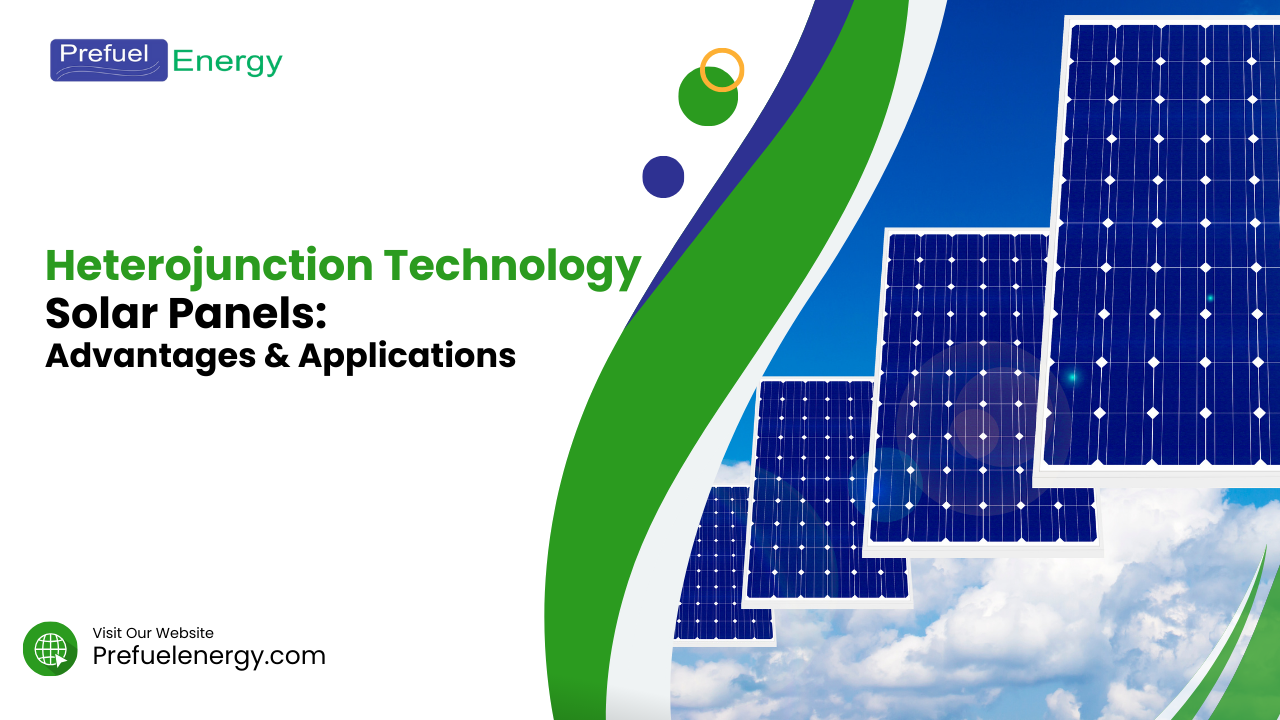Heterojunction Technology (HJT) solar panels represent a significant advancement in photovoltaic technology, combining the benefits of crystalline silicon and thin-film technologies. This article explores the structure, advantages, applications, and suitability of HJT solar panels.
Table of Contents
What are HJT Solar Panels?
Heterojunction (HJT) solar panels, also known as Silicon heterojunctions (SHJ) or Heterojunction with Intrinsic Thin Layer (HIT) solar panels, are made up of HJT solar cells that use sophisticated photovoltaic technology. HJT cells combine the advantages of crystalline silicon with thin-film technology.
These cells are made from an N-type monocrystalline silicon substrate with non-doped amorphous silicon layers (i-a-Si:H) placed on the surface. This novel structure improves the performance and efficiency of solar cells, which are then integrated into solar panels for practical use.
Key Components of HJT Cells

N-Type Monocrystalline Silicon Substrate
The foundation of HJT cells is an N-type monocrystalline silicon wafer. N-type silicon is characterized by its majority carriers being electrons, which allows for higher carrier mobility and lower light-induced degradation (LID). This substrate serves as the primary layer for charge carrier generation.
Intrinsic Amorphous Silicon Layer
On both sides of the N-type silicon substrate, a layer of intrinsic amorphous silicon (i-a-Si:H) is deposited. This undoped layer acts as a passivation layer, reducing surface defects and minimizing the recombination of charge carriers. This passivation enhances the open-circuit voltage (Voc) and overall efficiency of the solar cell.
Doped Amorphous Silicon Layers
Surrounding the intrinsic layers are P-type and N-type amorphous silicon layers. These layers are doped with trace amounts of other elements to modify their conductivity, forming a P-N junction essential for solar energy conversion. The P-type layer is typically on the front side, while the N-type layer is on the back.

Transparent Conductive Oxide (TCO) Layer
A layer of transparent conductive oxide, often Indium Tin Oxide (ITO), is applied to the surface of the solar cell. This layer provides excellent light transmittance while also allowing for electrical conductivity. The TCO layer is crucial for ensuring that light can penetrate the cell while maintaining efficient current flow.
Metal Electrodes
Thin metal electrodes are printed on the top and bottom of the solar cell to extract current. These electrodes are designed to be as thin as possible to minimize shading on the cell surface, allowing more light to reach the active areas of the cell.
Advantages of HJT Solar Cell Technology

1. High Efficiency
HJT solar cells achieve exceptional efficiency levels, with some models reaching up to 25% or more. This high efficiency is attributed to the unique structure that allows for better light absorption and conversion of sunlight into electricity. The combination of crystalline silicon and amorphous silicon layers optimizes energy capture, making HJT cells one of the most efficient solar technologies available today.
2. Excellent Low-Light Performance
HJT panels perform well in low-light conditions, such as cloudy days or during early mornings and late afternoons. This capability is crucial for maximizing energy production throughout the day, especially in regions with variable weather conditions.
3. High Bifaciality
HJT solar cells exhibit a high bifaciality factor, often exceeding 95%, allowing them to generate power from both the front and rear sides. This design significantly boosts overall energy output, particularly in installations where both sides of the panel can receive sunlight, such as carports or dual-sided solar farms.
4. Reduced Temperature Coefficient
HJT cells have a favorable temperature coefficient of approximately -0.243%/°C, indicating they are less sensitive to temperature increases compared to conventional solar cells. This characteristic allows HJT panels to maintain higher efficiency in elevated temperatures, making them suitable for hot climates.
Book Best HJT Solar Panels
5. Lower Degradation Rates
HJT solar panels exhibit lower first-year power degradation rates, typically around 1%, compared to 1.5% for TOPCon and 2% for PERC technologies. Over time, HJT cells also show lower annual degradation rates, enhancing their long-term performance and reliability.
6. Enhanced Durability
The design of HJT solar cells contributes to their durability. The use of double-sided glass and advanced encapsulation techniques provides resistance to weathering, corrosion, and mechanical stress. This durability ensures a longer lifespan, often exceeding 30 years, with stable performance throughout their operational life.
7. Cost-Effective Manufacturing
HJT technology simplifies the manufacturing process, requiring fewer production steps than traditional technologies like PERC. This efficiency can lead to cost savings in production, making HJT panels potentially more affordable in the long run despite a higher initial investment.
8. Aesthetic Appeal
HJT solar panels typically feature a sleek, all-black design, which can be more visually appealing for residential installations. This aesthetic quality can make them a preferred choice for homeowners looking to integrate solar technology without compromising the appearance of their property.
9. Versatile Applications
HJT technology is suitable for a wide range of applications, including residential, commercial, and utility-scale solar projects. Its high efficiency and performance characteristics make it ideal for various environments and installation types, including building-integrated photovoltaics (BIPV) and portable solar solutions

Applications of HJT Solar Panels
HJT solar panels are versatile and suitable for various applications:
- Agricultural Photovoltaics: Their high bifacial efficiency makes them ideal for agricultural settings, allowing for effective energy generation even under varying weather conditions.
- Carport Photovoltaics: HJT panels excel in urban environments where shading is common, effectively capturing scattered and reflected light.
- Rooftop Photovoltaics: Their durability and efficiency make them suitable for residential and commercial rooftops, particularly in regions with fluctuating weather.
- Regions with High Summer Temperatures: Their low temperature coefficient ensures minimal performance loss in hot climates.
- Regions with Poor Lighting Conditions: HJT panels perform well in low-light environments, making them suitable for northern regions with frequent cloud cover.
Conclusion
Heterojunction Technology solar panels offer numerous advantages, including high efficiency, excellent low-light performance, and versatility in applications. Their unique structure and materials position them as a leading choice for sustainable energy solutions in various environments. As the demand for efficient and reliable solar energy continues to grow, HJT technology stands out as a promising option for both residential and commercial installations.


